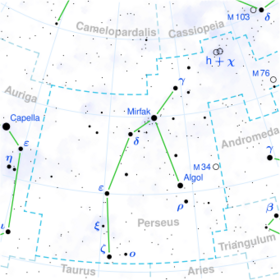Astronomy:58 Persei
| Observation data Equinox J2000.0]] (ICRS) | |
|---|---|
| Constellation | Perseus |
| Right ascension | 04h 36m 41.43017s[1] |
| Declination | +41° 15′ 53.3213″[1] |
| Apparent magnitude (V) | 4.26[2] |
| Characteristics | |
| Spectral type | K1II + B7V[3] |
| U−B color index | +0.81[2] |
| B−V color index | +1.24[2] |
| Astrometry | |
| Radial velocity (Rv) | +9.80[4] km/s |
| Proper motion (μ) | RA: −4.56[1] mas/yr Dec.: −17.84[1] mas/yr |
| Parallax (π) | 4.09 ± 0.38[1] mas |
| Distance | 800 ± 70 ly (240 ± 20 pc) |
| Absolute magnitude (MV) | -2.67[5] |
| Orbit[6] | |
| Primary | 58 Persei A |
| Companion | 58 Persei B |
| Period (P) | 28.8 yr |
| Semi-major axis (a) | 0.051″ |
| Eccentricity (e) | 0.64 |
| Inclination (i) | 81° |
| Longitude of the node (Ω) | 237° |
| Periastron epoch (T) | 1978.65 |
| Argument of periastron (ω) (secondary) | 191° |
| Details | |
| 58 Per A | |
| Mass | 6.8±0.2[7] M☉ |
| Radius | 56±11[8] R☉ |
| Luminosity | 1,698[5] L☉ |
| Surface gravity (log g) | 2.21[9] cgs |
| Temperature | 5,173±32[7] K |
| Metallicity [Fe/H] | −0.20[5] dex |
| Rotational velocity (v sin i) | 11.0[10] km/s |
| Age | 50.1±6.8[7] Myr |
| Other designations | |
| Database references | |
| SIMBAD | data |
58 Persei is a binary[3] and possibly a triple[12] star system in the northern constellation of Perseus. It has the Bayer designation e Persei, while 58 Persei is the Flamsteed designation. This system is visible to the naked eye as a faint point of light with an apparent visual magnitude of 4.26.[2] It is approximately 800 light years away from the Sun based on parallax,[1] and is drifting further away with a radial velocity of +10 km/s.[4]
This is a single-lined spectroscopic binary system with an orbital period of 28.7 years and an eccentricity of 0.65.[13] The primary member, designated component A, is an orange-hued (K–type) bright giant with a stellar classification of K1II.[3] The star is around 50[7] million years old with 7[7] times the mass of the Sun. Having exhausted the supply of hydrogen at its core, it has expanded to roughly 56[8] times the Sun's radius. It is radiating 1,698[5] times the luminosity of the Sun from its enlarged photosphere at an effective temperature of 5,173 K.[7]
The secondary, component B, appears to be a B-type main-sequence star with a stellar classification of B7V.[3] It is a suspected binary of unknown period with component masses of 3.3 and 1.2 times the mass of the Sun.[12]
References
- ↑ 1.0 1.1 1.2 1.3 1.4 1.5 Van Leeuwen, F. (2007). "Validation of the new Hipparcos reduction". Astronomy and Astrophysics 474 (2): 653–664. doi:10.1051/0004-6361:20078357. Bibcode: 2007A&A...474..653V. Vizier catalog entry
- ↑ 2.0 2.1 2.2 2.3 Ducati, J. R. (2002). "VizieR Online Data Catalog: Catalogue of Stellar Photometry in Johnson's 11-color system". CDS/ADC Collection of Electronic Catalogues 2237. Bibcode: 2002yCat.2237....0D.
- ↑ 3.0 3.1 3.2 3.3 Eggleton, P. P.; Tokovinin, A. A. (September 2008). "A catalogue of multiplicity among bright stellar systems". Monthly Notices of the Royal Astronomical Society 389 (2): 869–879. doi:10.1111/j.1365-2966.2008.13596.x. Bibcode: 2008MNRAS.389..869E.
- ↑ 4.0 4.1 Gontcharov, G. A. (2006). "Pulkovo Compilation of Radial Velocities for 35 495 Hipparcos stars in a common system". Astronomy Letters 32 (11): 759–771. doi:10.1134/S1063773706110065. Bibcode: 2006AstL...32..759G.
- ↑ 5.0 5.1 5.2 5.3 Anderson, E.; Francis, Ch. (2012). "XHIP: An extended hipparcos compilation". Astronomy Letters 38 (5): 331. doi:10.1134/S1063773712050015. Bibcode: 2012AstL...38..331A. Vizier catalog entry
- ↑ Heintz, W.D. (1997). "Photographic astrometry of binary and proper-motion stars. VII". Astronomical Journal 105 (3): 1188–1195. doi:10.1086/116503. Bibcode: 1997yCat.1239....0E.
- ↑ 7.0 7.1 7.2 7.3 7.4 7.5 Tetzlaff, N.; Neuhäuser, R.; Hohle, M. M. (2011). "A catalogue of young runaway Hipparcos stars within 3 kpc from the Sun". Monthly Notices of the Royal Astronomical Society 410 (1): 190–200. doi:10.1111/j.1365-2966.2010.17434.x. Bibcode: 2011MNRAS.410..190T. Vizier catalog entry
- ↑ 8.0 8.1 van Belle, G. T. et al. (2009). "Supergiant temperatures and linear radii from near-infrared interferometry". Monthly Notices of the Royal Astronomical Society 394 (4): 1925. doi:10.1111/j.1365-2966.2008.14146.x. Bibcode: 2009MNRAS.394.1925V.
- ↑ Soubiran, Caroline; Le Campion, Jean-François; Brouillet, Nathalie; Chemin, Laurent (2016). "The PASTEL catalogue: 2016 version". Astronomy & Astrophysics 591: A118. doi:10.1051/0004-6361/201628497. Bibcode: 2016A&A...591A.118S.
- ↑ De Medeiros, J. R.; Mayor, M. (1999). "A catalog of rotational and radial velocities for evolved stars". Astronomy and Astrophysics Supplement Series 139 (3): 433. doi:10.1051/aas:1999401. Bibcode: 1999A&AS..139..433D. Vizier catalog entry
- ↑ "58 Per". SIMBAD. Centre de données astronomiques de Strasbourg. http://simbad.u-strasbg.fr/simbad/sim-basic?Ident=58+Per.
- ↑ 12.0 12.1 Parsons, Sidney B. (May 2004). "New and Confirmed Triple Systems with Luminous Cool Primaries and Hot Companions". The Astronomical Journal 127 (5): 2915–2930. doi:10.1086/383546. Bibcode: 2004AJ....127.2915P.
- ↑ Batten, Alan H.; Fletcher, J. M.; MacCarthy, D. G. (1989). "Catalogue of the orbital elements of spectroscopic binary systems : 8 : 1989". Publications of the Dominion Astrophysical Observatory 17: 1. Bibcode: 1989PDAO...17....1B.
 |


